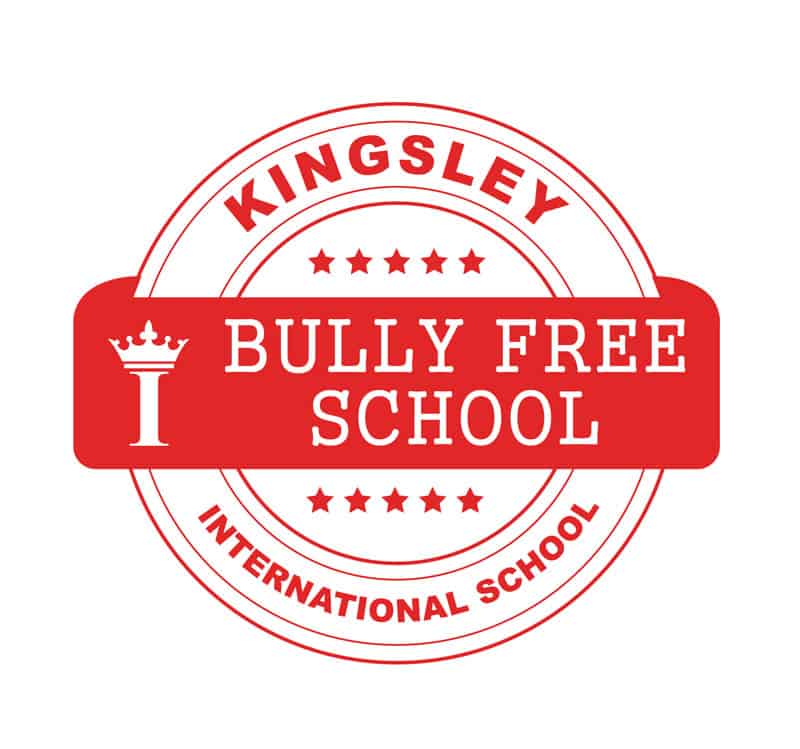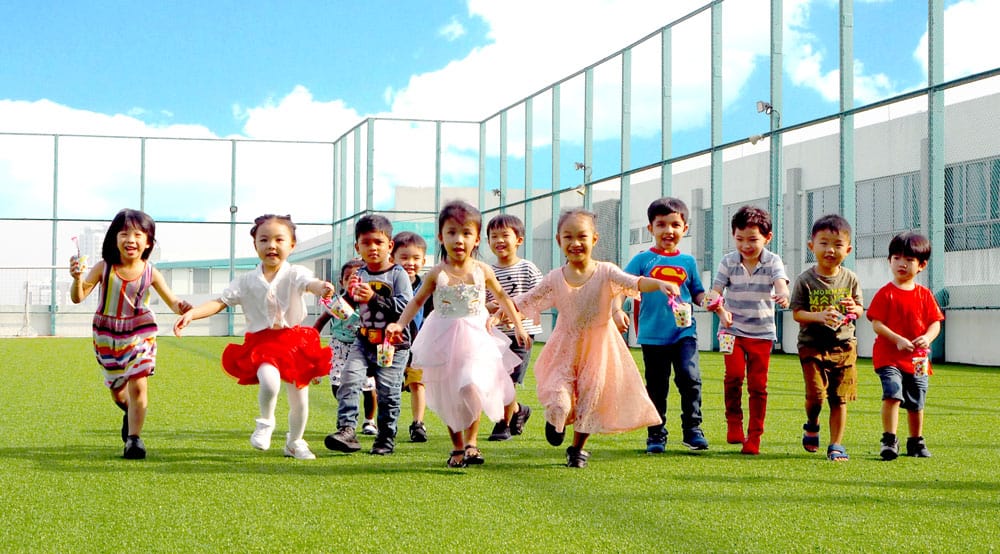Kingsley International School is a bully-free school. Our culture of care and trust is why our students, parents, and teachers believe in the Kingsley way. The School’s bully-free policies are preventive and restorative—as we believe harsh discipline does not benefit children. Our primary concern is to safeguard a reassuring environment for every child, where no one is singled out or ignored.
In our experience, we find that healthy behaviors flourish when kids feel understand and are understood. We want all our students to feel connected to the school community and we encouraged this through teacher or peer-to-peer interactions geared towards fostering caring, considerate, and reflective individuals.

Anti-bullying awareness is also one of the 3 pillars of the Personal, Social & Health Education (PSHE) program. PSHE focuses on 5 core values, anti-bullying, and financial education. Kids learn to manage themselves, their health, relationships, and money while exploring what it means to be a citizen of the world and country.
1. Defining Bullying
Bullying is a major issue that is difficult to be eliminated in schools. Bullying activity in school is a discipline problem and may interrupt the teaching and learning process. It often receives attention from parents who are concerned that such activity can develop into fights, which can lead to serious injury.
According to Ms Ellis the Chief Executive of Kingsley International School,
Bullies are often someone with a low self-esteem and have difficulty in coping with anger management issues.
They act out through physical or mental assaults on those less able to defend themselves. Generally, male bullies tend to be physically stronger than others whereas female bullies are perceived as popular in school.
Some suffer abuse at home through neglect or follow what their parents or adults are doing at home. Therefore, they resort to bullying to make them feel better.
2. Examples of Bullying Behaviors in School
There are different types of bullying. Below are some of the types of bullying that are prevalent:
Physical Bullying
This is one of the most prevalent types of bullying. Establishing superiority behavior to exert control over the victim. Release of anger.
Verbal Bullying
This type of bullying results in upsetting another student through teasing or taunting. Bullies often suffer from low self-esteem may believe this helps them to increase their social standings and feel better about themselves.
Emotional Bullying
This form of bullying involves intentionally or unintentionally causing emotional hurt to another student, such as spreading rumors, causing distress, excluding an individual from certain activities, or refusing to allow others to talk to the victim.
Cyber Bullying
Modern bullying is often done using technology. Social media platforms have allowed bullies to often go undetected and protected. Bullies also do not use real names and often assume a false identity to intentionally cause grief to others.
Social Bullying
Bullies may resort to segregating or dividing to conquer, usually to ensure strength and demand loyalty from victims, while many exerts rude behavior.
Most bullies assume their bullying characteristics through observation and become followers. This behavior is easily picked up after a series of events or in situations where difficult home life is present, it becomes second nature in a matter of time.
Most protective parents will argue that their child is not doing “harm” but if the behavior is not corrected at a young age, they may become a part of the child’s lifestyle in their future.
3. Identifying Bullies & Victims
Bullies can best be defined by their personality style. Researchers describe bullies as:
- Enjoying aggression and the rewards gained from aggressive acts;
- Lacking empathy for their victim;
- Lacking guilt for their actions;
- Dominating and like to be in charge;
- Having aggressive role models; and
- Thinking unrealistically about how the world should meet their needs.
There are two types of victims: passive victims and provocative victims. Passive victims generally do not defend themselves and can be characterized by:
- Being isolated during the school day;
- Lacking social skills;
- Being physically weak;
- Crying or yielding easily to bullies;
- Suffering from past trauma; and/or
- Having learning difficulties.
Provocative victims generally tease and provoke bullies, but do not have the social or physical skills necessary to defend themselves. Provocative victims can be characterized by:
- Being easy to arouse emotionally;
- Behaving in a manner that maintains the conflict; and/or
- Possibly having attention deficit hyperactivity disorder (ADHD).
Children who are being bullied may likely:
- Have torn, damaged or missing pieces of clothing, books or other belongings;
- Have unexplained cuts, bruises or scratches from fighting;
- Have few, if any, friends with whom he or she spends time;
- Seem afraid of going to school, walking to and from school, riding the school bus, or taking part in organized activities with peers;
- Lose interest in school work or suddenly begin to do poorly; and/or
- Complain frequently of headaches, stomach aches or other physical problems.

4. Steps to Take to Reduce or Eliminate Bullying Culture
The best way to address this bullying culture is to stop it before it starts. We at Kingsley are taking the following steps to reduce or eliminate bullying.
- Training staff, teachers and students to prevent bullying by addressing the many types of bullying consistently. Over time, this can be prevented. Enforce policies and rules for all students to observe and obey.
- We incorporate topics of all types of bullying in class lessons and activities.
- We place signage and reminders at various points of the school to remind all children.
- We display policies for students to know of the consequences of bullying at prominent
- areas.
- We seek parents’ /guardians assistance by early warnings and through messages on students
- bullying intentionally or unintentionally.
- We hold assembly or town hall meets for students to make speeches / have role plays or through creative writings to address bullying.
- We encourage students to report bullying or acts of hurting another immediately. The school acts on all improper acts by bullies within 24 hours.
- We have a student body and a Disciplinary Board who works with the school counsellor to ensure bullies and victims are counselled and proper reflective actions are carried out. We ensure that parents are informed immediately.
- We do not believe in harsh punishment for bullies, who often are in denial of their acts
- or are innocent till proven they have intentionally hurt another.
- We listen to all children who bullies or are victims – to encourage them to recognize their
- own actions; which must not be repeated / be forced to suffer the consequences / facing
- in-house suspension or expulsion.
- We watch for signs of bullying by students displaying signs of aggression or depression.
The school have not faced any serious bullying for the last six years but instead, bullying tends to come from the adults or parents through self-denial that their children are in need of counselling. Minor mistakes or acts of mischief, if not addressed from the beginning tells the bully that what they have committed is not wrong. This encourages them to continue this misguided behavior as they grow older.

5. What Can Parents of Victims Do To Help?
We believe that early intervention helps.
Parents can help:
- Take school reporting seriously.
- Do not go into denial or defend mode.
- Work with the school to correct or encourage – bully or victim to attend counselling
- sessions arranged by the school.
- Support the child – be it a bully or victim – talk to them at home and understand them.
- Closely monitor them at home with their activities – their mix of friends or activities over the social media.
If left unattended to or untreated, bullies grow bolder, victims suffer consequences and this may lead to more drastic results leading to major events which often leads to bitter outcomes.





